How to clean the washing machine tray from fossilized powder?
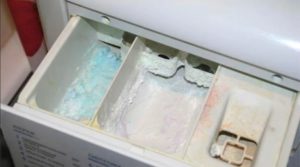 The washing machine itself requires periodic cleaning. Without regular “cleaning,” dirt and plaque will accumulate inside the machine, which over time will lead to clogging or overheating of the elements. The detergent tray will be among the first to suffer - powder residues with impurities from the water supply settle on the walls of the dispenser and prevent the outflow of water. You won’t be able to wash with a clogged dispenser; you must first clean the washing machine tray of any fossilized powder. Let's figure out how to do this efficiently and as quickly as possible.
The washing machine itself requires periodic cleaning. Without regular “cleaning,” dirt and plaque will accumulate inside the machine, which over time will lead to clogging or overheating of the elements. The detergent tray will be among the first to suffer - powder residues with impurities from the water supply settle on the walls of the dispenser and prevent the outflow of water. You won’t be able to wash with a clogged dispenser; you must first clean the washing machine tray of any fossilized powder. Let's figure out how to do this efficiently and as quickly as possible.
Why do you need to clean frequently?
Any household appliance gets dirty over time and needs care. Each manufacturer must specify in the factory instructions the nuances and frequency of cleaning. Without following these recommendations, the machine will fail faster.
Many users are sure that it is not necessary to clean the powder receptacle - it is much more important to take care of the drum or debris filter. But this is not so: the supply of water to the machine depends on the dispenser. If the pipes and trays are clogged with petrified powder, then the outflow is disrupted, the drum does not fill, and the system generates an error.
Soap and lime deposits constantly form on the walls of the tray. There are several reasons for this: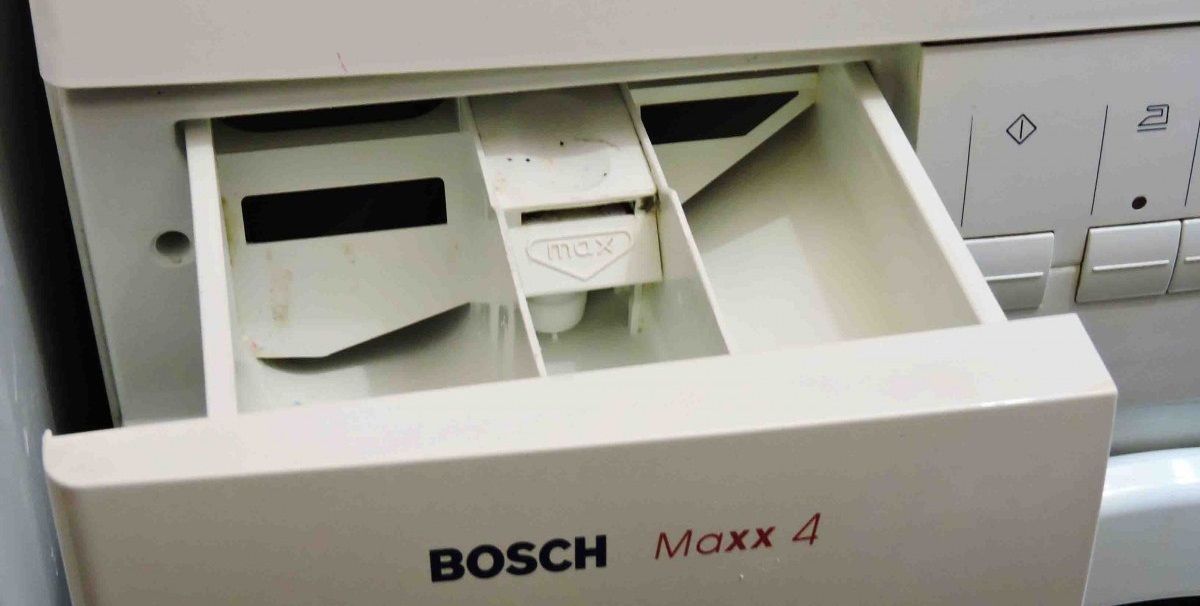
- hard water with a lot of impurities and dirt (all this settles on surfaces and hoses);
- low-quality detergent (poor powder dissolves less well);
- weak pressure in the risers (the powder is not completely washed off);
- exceeding the dosage (during the measured time of collection, the water does not have time to wash off the entire handful of the product).
The situation gets worse when using bleaches and conditioners. Such products are distinguished by a viscous texture, after which a sticky film remains on the walls of the powder receptacle. It hardens and also “collects” dust, dirt and lime.
It is recommended to wash the powder receptacle of your washing machine every week!
Gradually, the layer of dirt becomes thicker, which eventually clogs the powder receptacle or its pipes. The consequence of a blockage can be either the washing machine’s refusal to start washing or its complete failure - the tray overflows and floods the control board. It’s better not to take risks, but to constantly monitor the condition of the dispenser.
Mechanical cleaning of the tray
The powder receptacle is considered one of the dirtiest elements of a washing machine - only the tank and hoses get dirty faster than it. But unlike its “colleagues”, the tray is easier to wash: most cuvettes can be easily pulled out of the machine body. There are no difficulties with visual inspection of the dispenser; it is always in sight, so it is easier to control the degree of its contamination.
Anyone can cope with cleaning the powder receptacle. You just need to figure out how to remove the tray from the case. On most washing machines, the dispenser is pulled out as follows:
- the tray opens all the way;
- there is a blocking tab in the central cuvette (usually red);
- the tongue is pressed;
- The powder receptacle is pulled out of the machine.
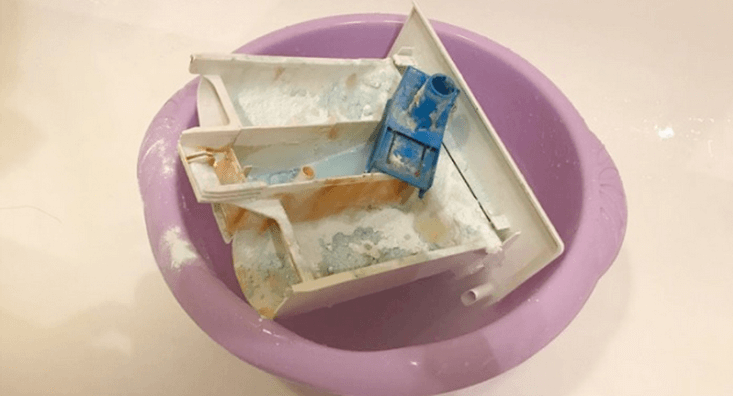
The exception will be washing machines from Indesit and Aristont - they are equipped with atypical powder receptacles. The cuvettes are also built into the body on some vertical models. But even here you can remove the dispensers. You just need to carefully study the instructions.
To clean the powder receptacle you will need laundry soap and a toothbrush!
After “dismantling” the tray should be cleaned. The algorithm is as follows:
- rinse the container thoroughly under the tap;
- walk along the walls of the tray with a soapy sponge or brush;
- rinse the element;
- wipe dry.
An old toothbrush is used to remove plaque in hard-to-reach places. You need to rub with moderate force so as not to tear off the raised marks for dosing the powder. If the dirt does not give in, then the cuvette is soaked in a warm lemon solution for 2-4 hours.
Use of special cleaning agents
Sometimes manual cleaning does not help, and a layer of trapped powder, lime or mucus remains in the tray. Mold, rust and unpleasant odors can also “resist.” In this case, soaking will not help - only using special household chemicals.
Special tools are needed to dissolve fossils and remove fungus. They are called washing machine cleaners, are available in powders or gels and are able to remove any dirt, disinfecting the entire machine. With their help, not only the dispenser will be washed, but also other elements of the system.
Before using a washing machine cleaner, carefully read the instructions on the product packaging!
Cleaners are used as follows:
- the required dosage is calculated (you need to follow the instructions so as not to overdo it);
- the product is poured into the powder receptacle;
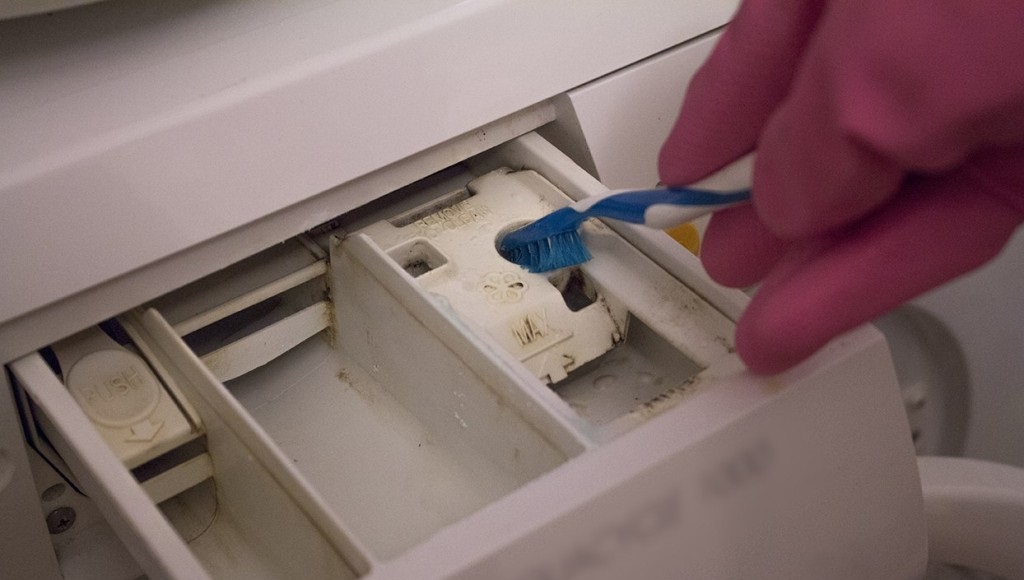
- the washing drum is emptied of clothes (washing goes idle);
- any mode with water heating up to 60-95 degrees is selected;
- additional rinse is activated;
- the cycle starts.
All! As soon as the washing machine completes the program, cleaning is completed. All that remains is to wipe the tray and drum dry.But you should understand that if the machine is heavily soiled, the cycle will have to be repeated. Use instead of cleaner Galgon is not allowed - it only softens the water and does not dissolve scale and deposits.
Keep the litter box clean
It is easier to prevent the tray from clogging than to clean off the fossilized powder. To avoid contamination, it is necessary to regularly monitor the cuvettes and the washing machine as a whole. As a rule, it is enough to follow the following rules:
- use high-quality detergents;
- monitor the dosage of the powder;
- Rinse the tray and wipe dry after each use of the washing machine;
- leave the compartment open until completely dry;
- Every 6-10 washes, clean the dispenser from scale and deposits.
It is recommended to leave the tray open after each wash until completely dry!
The powder receptacle must be clean. Then the powder will “reach” the drum in full, and the machine will not slow down due to blockage.
Interesting:
Reader comments
- Share your opinion - leave a comment


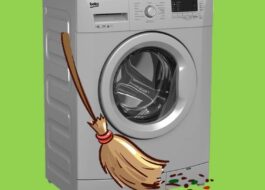
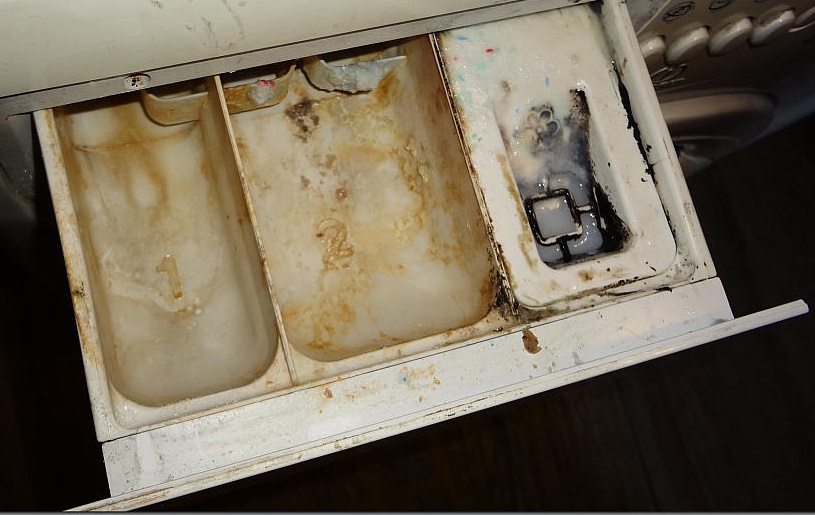
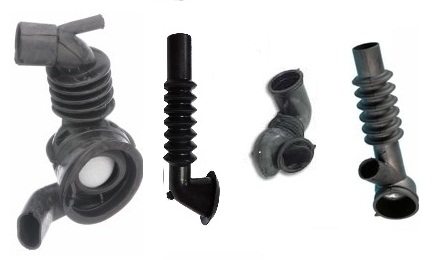
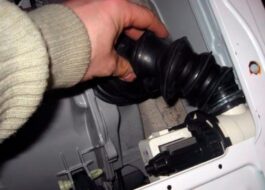















Add a comment